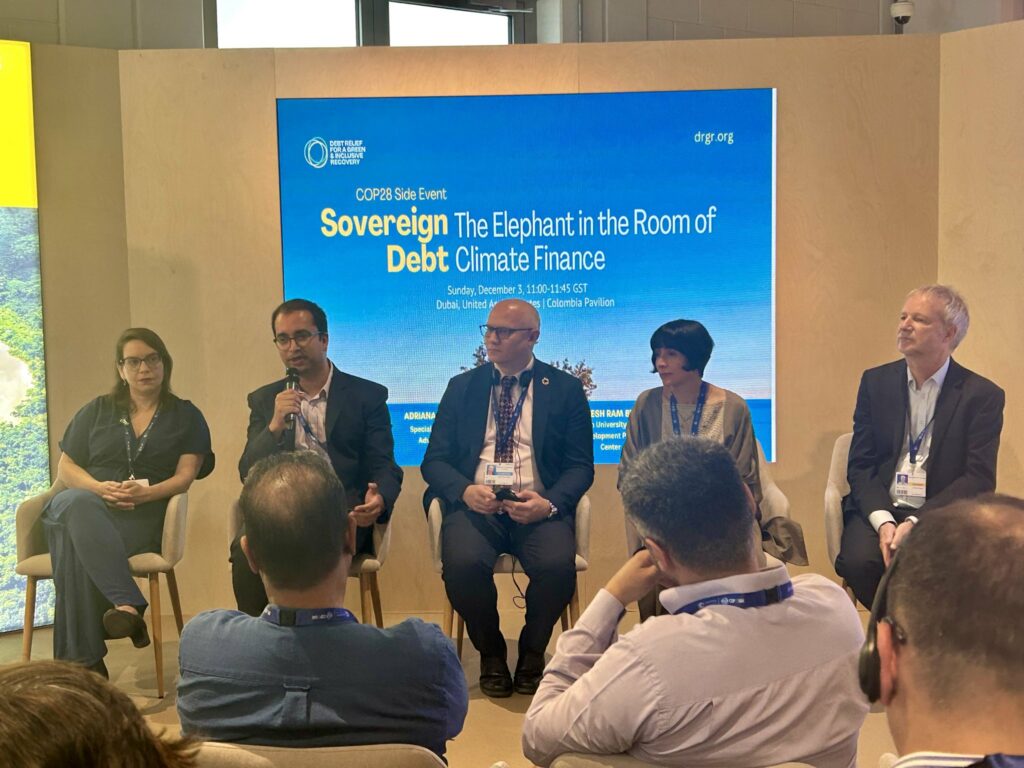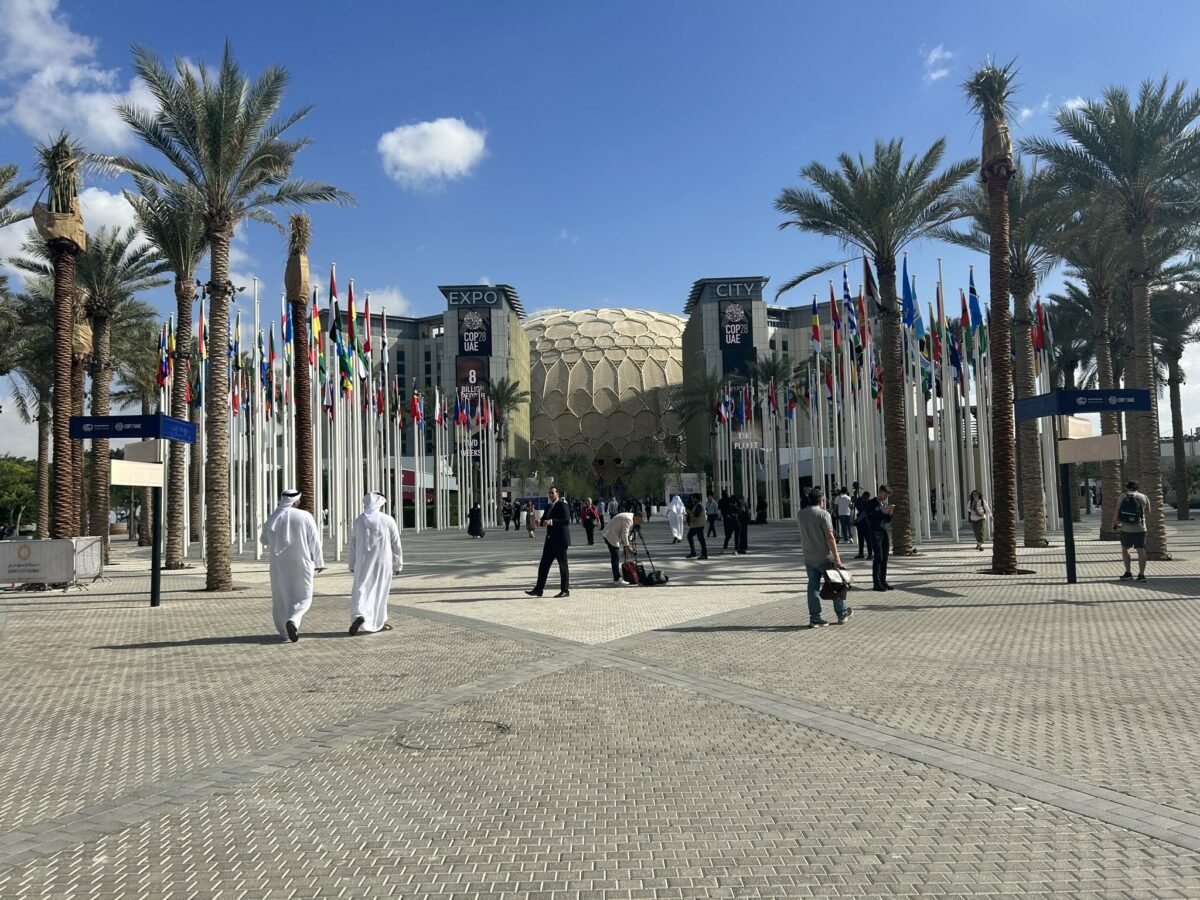The spotlight at this year’s United Nations Climate Change Conference (COP28) was firmly on the Global Stocktake, tasked with evaluating the advancements made under the 2015 Paris Agreement. Yet, what developments have taken place in Dubai with regard to the debt crisis?
by Sarah Ribbert (Project Coordinator) & Arabella Wintermayr (Editor)
Dear Reader,
The eagerly anticipated 2023 United Nations Climate Change Conference (COP28), held in Dubai, occurred at unprecedented scale, drawing nearly 100,000 participants and setting records for the highest number of fossil fuel lobbyists participating in the climate talks. The primary focus of this year’s conference was the inaugural Global Stocktake (GST), a pivotal assessment of the 2015 Paris Agreement’s implementation and the collective strides towards its objectives.
COP28 kicked off on an optimistic note as details and structures for the loss and damage fund (LDF) were swiftly adopted in the opening session. This fund, conceived at the previous COP27 in Egypt, aims to provide crucial support to developing nations bearing the brunt of climate change. However, the financial commitments made during COP28 revealed a stark reality: just $700 million in pledges were achieved, representing less than 0.2 percent of the staggering economic and non-economic losses incurred annually by developing countries due to climate change.
While the final COP28 agreement is an important step that signals – for the first time – the need to bring about the end of the fossil fuel era, the agreement, however, lacks a clear commitment to a complete phase-out. This is due in large part to the massive resistance of countries whose economies are based on the production and sale of oil, most notably Saudi Arabia.
Speaking at an official COP28 side event, DRGR researcher Rishikesh Ram Bhandary emphasized the close link between debt distress and climate ambition. Strikingly, the final GST text notes that additional forms of grants and concessional finance will be essential for ensuring sustainable, low-carbon transitions and recognizes the link between fiscal space and climate and development action.
Still though, the final text was found wanting by some. The Alliance of Small Island States (AOSIS), while acknowledging that agreement reflects inputs from the Small Island Developing States, expressed concerns about a “litany of loopholes,” particularly regarding finance. For developing nations in dire need of substantial funding for transitioning away from fossil fuels, the final text lacks clarity on how the necessary funding will be raised, especially for adaptation measures.
Recognizing the Debt Crisis Is a Barrier to Global Climate Goals
While the lack of participation of multilateral development banks (MDBs) in debt negotiations remains a central issue, World Bank Group President Ajay Banga announced that the Bank would extend the scope of Climate Resilient Debt Clauses in its loans to cover all existing World Bank loans for the most vulnerable countries. The provisions outline a mechanism allowing for a pause of repayments in the face of climate-induced calamities, like cyclones or floods, which have the potential to deplete a nation’s resources.
Banga emphasized that these interruptions will not only encompass the repayment of the principal amount, but also on interest payments. This adjustment aims to ensure that governments can direct their attention towards preserving access to essential resources, such as food, water, power and other endeavors crucial for recovery. Separately, major creditors France and the United Kingdom, alongside prominent MDBs also declared that they will expand the use of climate-resilient debt clauses in their lending.
However, as DRGR researcher Marina Zucker-Marques points out in the case of Malawi, which is currently undergoing debt restructuring, a holistic approach to debt restructuring is essential to ensure timely and sustainable recovery. Achieving the levels of finance necessary to boost investments in climate and development requires a combination of debt relief, alongside a substantial increase in aid, grants and affordable finance from MDBs and official creditors alike.
In this context, a new working paper by the International Monetary Fund (IMF) on how the Brady Plan delivered debt relief is interesting. Brady Bonds have been a cornerstone of the DRGR proposal.
Prior to COP28, the collapse of Zambia’s bondholder deal renewed doubts about the feasibility and effectiveness of the Group of 20 (G20) Common Framework. DRGR Project Co-Chair Kevin Gallagher commented that the Common Framework has not been a success and that a reset is sorely needed. The refusal of Zambia’s official creditors to agree to a deal that so heavily favored bondholders reveals a fundamental fracture in the concept “Comparability of Treatment” between creditors. A recent study by the DRGR Project crunched the numbers to find a fair Comparability of Treatment that goes one step further and includes MDBs.
Additionally, leading MDBs at COP28 launched a “Joint Declaration and Task Force on Credit Enhancement for Sustainability-Linked Sovereign Financing”, which appears to focus primarily on the private sector and the mobilization of credit enhancements for sustainable climate sovereign financing – leaving the issue of unsustainable debt burdens unaddressed.
As many countries in the Global South lack the fiscal space to make necessary investments in climate and development goals, the launch of the Expert Review on Debt, Nature, and Climate by Colombia, Kenya and France builds on the momentum created at the Summit for a New Global Financial Pact in Paris in June 2023.

The close relationship between the sovereign debt crisis and climate action was also the topic of a DRGR side event at COP28, where Susana Muhamad, Minister of Environment and Sustainable Development of Colombia emphasized that the current rules of the international financial system do not allow for a just transition for all. Adriana Abdenur, Special Advisor to the Brazilian President, pointed to the effects of inequality caused by climate change and debt. “We need to think not only in terms of debt restructuring, debt forgiveness and accelerating the G20 Common Framework, but also think more ambitiously and creatively,” she commented.
For an ambitious package that would give the Global South the chance to invest in a green and inclusive transformation, DRGR Co-Chair Maria Fernanda Espinosa and DRGR Researcher Rishikesh Ram Bhandary argue in Project Syndicate, “To address the debt-climate nexus at COP28 and beyond, policymakers should focus on three objectives: a more inclusive and efficient debt-restructuring process; more concessional finance; and expansion of the size and remit of multilateral development banks (MDBs).”
In all the COP28 proceedings saw remarkable progress in some areas – the establishment of the loss and damage fund, an acknowledgment of the connections between debt and climate change – and yet fell short of the kind of galvanizing action many had hoped for. In the year ahead, it will be even more crucial for the international community and MDBs in particular to act with great ambition and clarity to tackle the interlocking problems of debt distress and climate change.
Thanks for reading, and until next time.
Drop us a line with your thoughts: ribbert@boell.de
